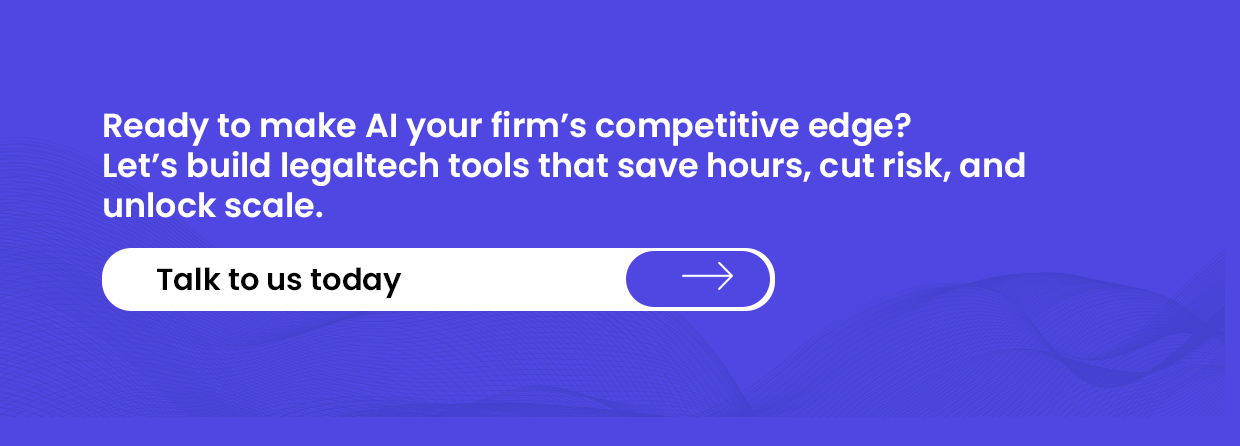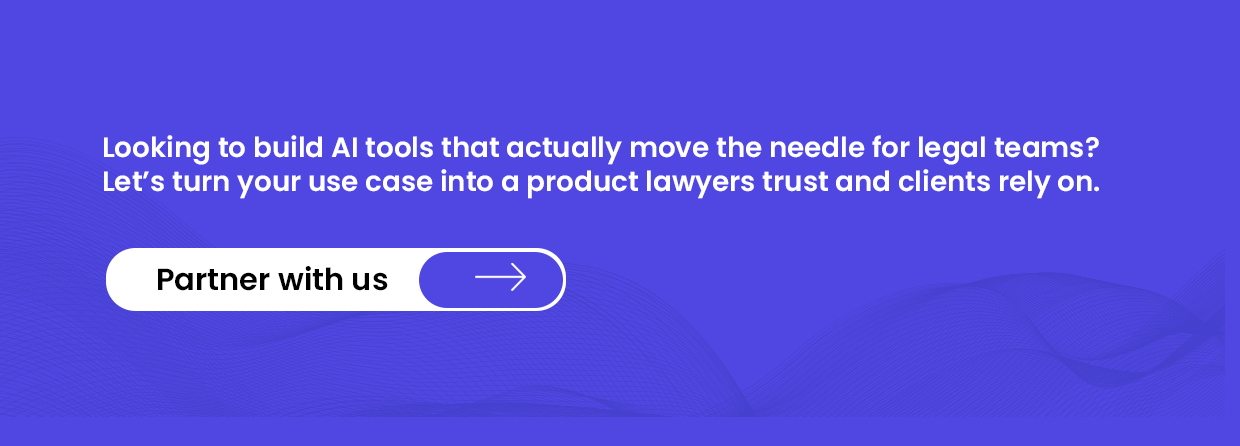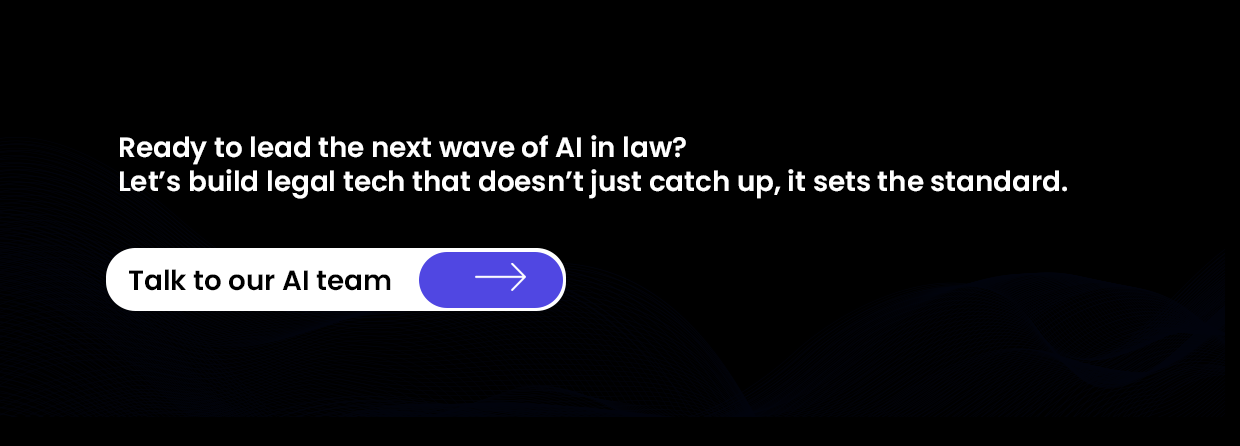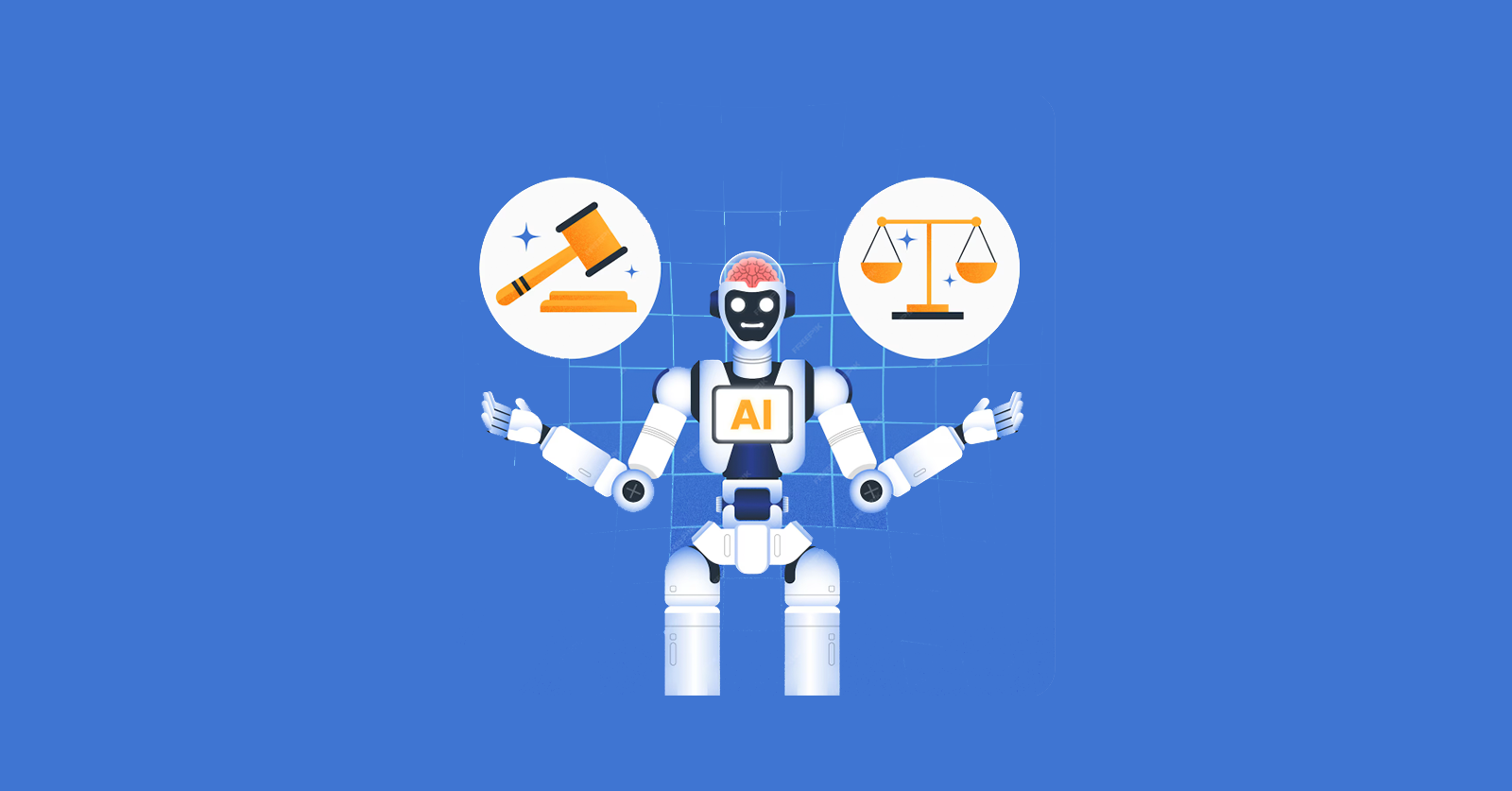
The legal world has always revolved around logic, precedent, and precision – qualities that make it a natural fit for artificial intelligence. But this isn’t about replacing lawyers with machines. It’s about augmenting legal teams with smarter tools that can process massive volumes of data, flag hidden risks, and free up billable hours for higher-value work.
From contract analysis to legal research, from due diligence to dispute prediction – AI is quietly reshaping how law firms, in-house teams, and courts operate. And it’s not a matter of if this change will happen, but how fast your practice is ready to adopt it.
This article explores the most high-impact, real-world applications of AI in the legal domain – where it’s delivering results, what use cases are gaining traction, and how forward-thinking firms are using it to stay competitive in a tech-driven era.
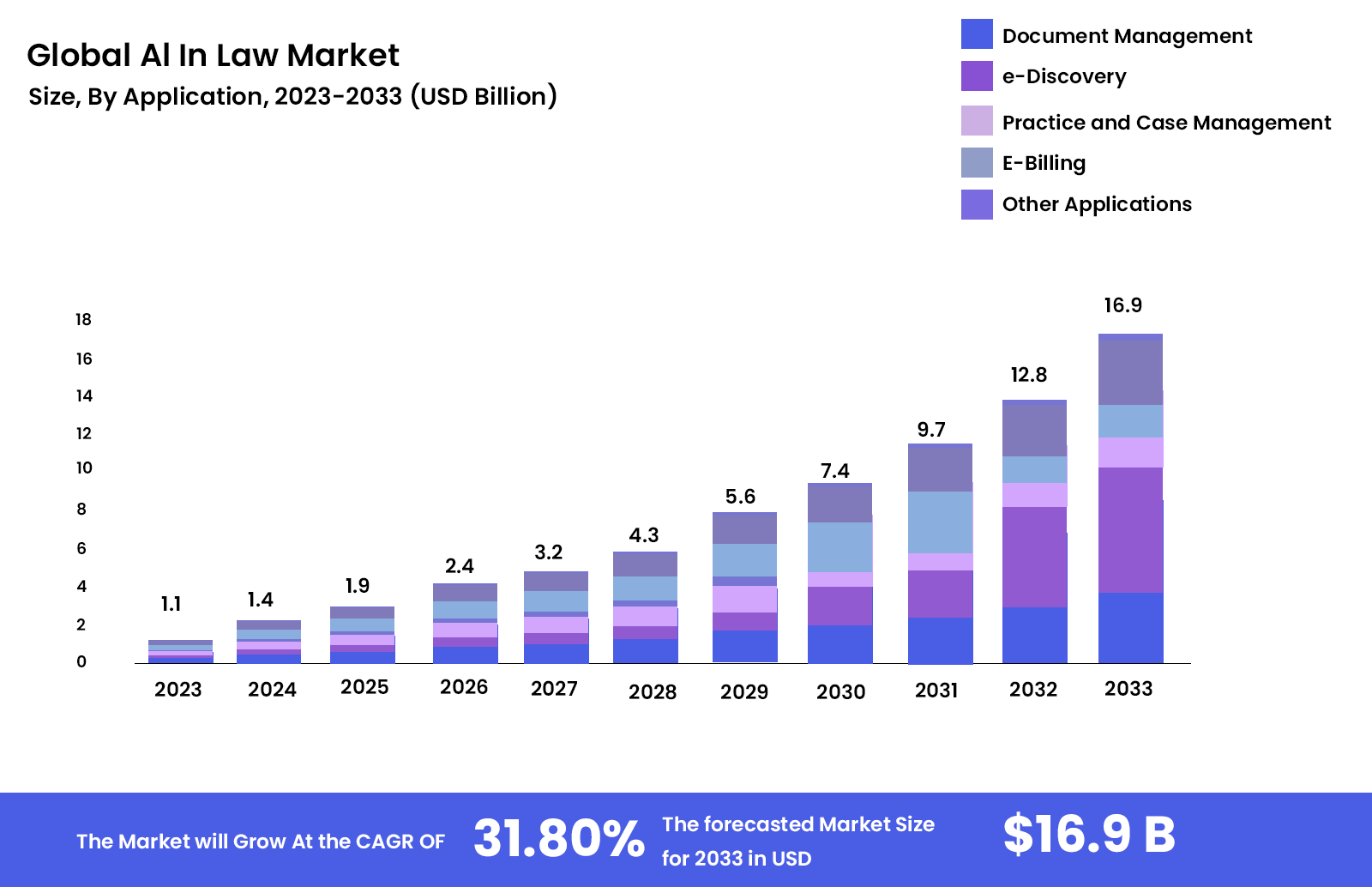
What’s Lacking in Today’s Legal Domain
Despite its reputation for rigor and structure, the legal field still runs on workflows that are slow, siloed, and heavily manual. Mountains of case files, rigid research cycles, delayed contract reviews, and time-consuming due diligence continue to dominate day-to-day operations – even in top-tier firms.
One of the biggest challenges is information overload. Legal professionals must comb through thousands of documents, precedents, and statutes – often under pressure – just to extract a few relevant points. That’s hours of high-cost time spent on tasks that, while necessary, don’t require human judgment at every step.
Another major bottleneck is contract lifecycle inefficiency. Drafting, reviewing, redlining, and negotiating contracts is still largely manual for many firms, opening the door to missed clauses, overlooked risks, and version control chaos. And while most firms have document management systems, few are actively using them to extract insights or identify patterns across cases.
There’s also the issue of accessibility and affordability. Legal services remain prohibitively expensive for a large portion of the population. AI holds the potential to lower the barrier – by automating standard procedures, streamlining advisory workflows, and enabling self-service platforms for lower-risk matters.
In short, the current system is burdened by inefficiencies, prone to human error, and unable to keep pace with the demands of modern commerce and compliance. This is exactly where AI comes in – not to disrupt the law, but to elevate its precision, speed, and reach.
Key Benefits of AI in the Legal Space
AI isn’t just a futuristic add-on – it’s becoming a competitive edge for legal teams that want to work faster, think deeper, and deliver more value with less friction. Whether applied to research, drafting, or client service, AI is helping the legal profession shift from reactive to proactive, and from time-intensive to insight-driven.
1. Dramatically Reduced Research Time
Legal research that once took hours can now be completed in minutes. AI-powered tools can scan case law, statutes, and regulatory frameworks at scale, highlighting relevant precedents or contradictory rulings with far greater efficiency. This frees attorneys to focus on analysis and strategy, not just fact-finding.
2. Faster and Safer Contract Reviews
AI-based contract analysis tools can flag anomalies, suggest revisions, and highlight missing clauses instantly. For firms handling high volumes of similar contracts – NDAs, vendor agreements, lease documents – this alone can shave days off deal cycles while reducing risk.
3. Enhanced Accuracy and Consistency
AI minimizes the human error often introduced by fatigue, time pressure, or oversight. Whether it’s redlining a complex agreement or cross-referencing jurisdiction-specific requirements, AI keeps results consistent – something even seasoned legal teams struggle with at scale.
4. Predictive Insights and Case Outcomes
By analyzing historical data and past rulings, AI tools can estimate the likelihood of success in litigation or arbitration. This kind of insight helps clients make informed decisions and gives attorneys a strategic edge in how they argue or settle cases.
5. Better Client Service and Retention
AI-powered chatbots and automated advisory tools can answer routine client queries 24/7, offer instant document generation, or streamline onboarding – all of which improve the client experience while preserving attorney bandwidth for higher-level work.
6. Lower Operational Costs
With AI handling a chunk of the routine legal grunt work, firms can reduce their dependence on large support teams or costly outsourcing. This opens up space to redirect resources into higher-margin areas like strategy, client expansion, or technology investment.
7. Greater Access to Justice
For underserved communities or startups priced out of traditional legal support, AI can be a force multiplier – offering basic legal guidance, generating documents, or triaging issues before they escalate. It doesn’t replace human lawyers, but it does make the system more reachable.
In the right hands, AI is not a threat to legal professionals – it’s leverage. It enhances speed, reduces risk, improves outcomes, and helps lawyers focus on the work only they can do.
Where AI is Transforming the Legal World – Real-World Applications Across the Ecosystem
AI is no longer a side experiment in the legal industry – it’s the engine behind faster decisions, leaner operations, and smarter client service. From solo practitioners to multinational firms, legal professionals are integrating AI not to replace human expertise, but to amplify it. Below are some of the most powerful applications of AI in law today, each grounded in real use cases and day-to-day relevance.
1. Contract Review and Risk Detection
Contracts are the lifeblood of any business, yet reviewing them remains one of the most time-consuming tasks in a legal department. AI-powered platforms like Kira Systems and Luminance can scan hundreds of contracts in minutes, automatically flagging non-standard clauses, missing terms, and potential risks. For example, during a high-stakes M&A deal, an AI system can instantly surface indemnity issues, change-of-control clauses, or silent liabilities buried in boilerplate. Legal teams not only move faster but with greater precision – reducing missed risks and improving client confidence.
2. Legal Research and Case Law Discovery
Traditional legal research is slow, manual, and reliant on human memory. AI tools like Casetext’s CoCounsel or Westlaw Edge use natural language processing to surface relevant case law and statutory references within seconds. Picture an attorney preparing a motion in a complex tort case: instead of keyword-hunting in multiple databases, they ask the AI to identify past rulings in similar fact patterns and jurisdictions. What once took days is condensed into focused, on-point insights in under an hour.
3. E-Discovery and Litigation Prep
In complex litigation or investigations, firms often receive terabytes of data – emails, Slack messages, PDFs, financial logs. AI streamlines the discovery process by clustering related documents, identifying privileged content, and extracting key facts. In a securities fraud case, for instance, a firm might use predictive coding to identify patterns of insider knowledge across thousands of communications – ensuring no smoking gun gets overlooked, and no budget is wasted on irrelevant reviews.
4. Litigation Outcome Prediction
AI doesn’t just help lawyers research – it helps them strategize. Tools like Lex Machina and Premonition analyze historical court data to estimate litigation success rates based on judge behavior, jurisdiction, and case type. A general counsel considering whether to litigate or settle can model outcomes with actual win-loss data – not gut feeling. This makes decision-making more data-driven and less emotionally reactive.
5. AI-Powered Legal Assistants and Chatbots
Client intake and support can easily drain internal time. Law firms are increasingly turning to AI-driven chatbots and virtual legal assistants to handle FAQs, triage service requests, and generate common documents like NDAs or letters of demand. Imagine a startup needing a shareholder agreement at midnight. Instead of waiting days for a callback, they use the firm’s AI assistant to draft a basic version – then loop in an attorney for review. It’s 10x faster service without sacrificing quality control.
6. Intellectual Property Management
Trademark clearance, patent research, and IP infringement monitoring are areas ripe for automation. AI systems can now search global IP databases, identify similar marks, and assess the risk of conflict – instantly. A fashion brand launching a new line might use AI to validate brand names across jurisdictions before applying, drastically reducing the risk of rejection or costly rebranding later.
7. Compliance Monitoring and Regulatory Intelligence
Whether it’s GDPR in Europe or the CCPA in California, regulations evolve constantly. AI tools can parse through complex legislative updates, highlight changes that affect your client’s business, and even suggest policy revisions. In heavily regulated sectors like finance or healthcare, this becomes a proactive compliance engine – saving time, fines, and reputational damage.
8. Document Drafting and Smart Templates
AI doesn’t just review documents – it writes them. Tools like LawGeex or Spellbook allow firms to automate the drafting of standard contracts, legal notices, or responses, pulling in firm-approved language and tailoring content based on the context. A junior lawyer drafting a vendor agreement, for example, can now generate a first draft using AI in minutes, rather than starting from scratch – freeing them to focus on negotiation or edge-case customization.
9. Billing, Timekeeping, and Practice Management
For most firms, tracking time and managing operations is a constant friction point. Billable hours get underreported, invoices are delayed, and administrative tasks chip away at profitability. AI tools now automate much of this – capturing time entries in the background based on calls, emails, and document activity, and assigning them to the right matters. Billing software uses AI to flag inconsistencies, missed hours, or unapproved rates before invoices are sent. A managing partner reviewing monthly performance can see trends across practice areas – who’s overperforming, which clients are dragging margins, or where resourcing needs to shift. For small and mid-sized firms, this turns billing from guesswork into strategy – and prevents revenue from slipping through the cracks.
10. Access to Justice and Pro Bono Innovation
One of AI’s most meaningful applications lies in democratizing legal support. Nonprofits and civic tech initiatives are using AI to help users generate asylum applications, resolve tenant disputes, or fight unfair fines – without needing a full-time attorney. For firms with pro bono arms, integrating such tools means serving more people, more efficiently.
Each of these use cases isn’t theoretical – they’re already changing how legal services are delivered. The firms adopting them aren’t just optimizing workflow – they’re unlocking scale, accuracy, and access that would have been impossible with manual methods alone.
Challenges and Limitations of Using AI in Law
While AI is undoubtedly a powerful tool for modernizing legal practice, it doesn’t come without trade-offs. In fact, the very characteristics that make law so precise – nuance, context, and ethical responsibility – can also complicate AI adoption.
One of the biggest challenges is contextual interpretation. Legal reasoning often depends on subtle distinctions in language, jurisdictional variations, or implied intent. While AI can recognize patterns and surface precedents, it still struggles to grasp the grey areas – like whether a clause is “commercially reasonable” or a term is deliberately vague for negotiation flexibility. In such situations, over-reliance on AI can result in overconfidence, or worse, critical misinterpretation.
There’s also the matter of data quality and bias. AI systems are only as good as the data they’re trained on – and legal data is notoriously fragmented, incomplete, or outdated. If your training set is skewed, your predictions may unintentionally reflect bias in past judgments or systemic inequities. This becomes especially concerning in criminal law, immigration, or civil rights cases, where flawed outputs can impact lives, not just outcomes.
Security and confidentiality are another major concern. Feeding sensitive client data into third-party AI tools raises questions about data protection, privilege, and regulatory compliance. Even if an AI tool is technically secure, not all platforms are fully built for the demands of legal privilege or jurisdiction-specific privacy standards – particularly when hosted in cloud environments.
Then there’s the human resistance – a natural but real barrier to adoption. Many lawyers remain skeptical of AI’s reliability or feel that automation threatens their role. In reality, AI isn’t here to replace lawyers, but to eliminate the drudgery – yet firm leaders must actively champion that mindset shift if adoption is to succeed.
And finally, explainability remains a gap. When AI recommends a clause, suggests a precedent, or flags a document as “risky,” attorneys need to understand why. If the system can’t explain its logic – or if that logic is hidden in black-box algorithms – it becomes hard to trust the tool in high-stakes legal environments.
In short, AI in law isn’t plug-and-play. It demands thoughtful integration, strong governance, and a balance between speed and oversight. The most successful firms won’t be the ones who adopt AI first – they’ll be the ones who do it wisely.
The Future of AI in the Legal Industry
The next chapter of AI in law won’t just be about better automation – it’ll be about deeper intelligence, seamless integration, and broader access to justice. As the technology matures, we’ll move beyond basic task support and toward full-cycle legal intelligence platforms that can assist across research, drafting, compliance, and even client engagement.
One of the most promising frontiers is generative AI fine-tuned for legal workflows. Instead of relying on general-purpose models, we’re seeing the rise of domain-specific tools trained on high-quality case law, statutes, and firm-level precedent libraries. These systems will be able to draft full contracts, generate legal arguments, or synthesize entire case histories based on natural language prompts – without compromising precision.
We’re also likely to see AI take on more strategic advisory roles, especially as platforms begin to integrate real-time business data, risk models, and regulatory updates. Imagine a system that doesn’t just suggest how to draft a clause, but also flags how likely it is to trigger negotiation pushback based on past deals. Or one that alerts in-house counsel the moment a new regulation may impact an existing vendor contract.
Legal accessibility will also see a massive boost. With more intuitive AI tools available on mobile and web, individuals and small businesses will gain access to basic legal guidance, document generation, and compliance insights without needing to engage full-service firms – narrowing the justice gap for underrepresented populations.
Of course, regulation will evolve alongside adoption. We can expect new frameworks governing AI transparency, liability, and ethical use – especially in litigation, public defense, and criminal sentencing. Firms that embrace governance and accountability early will be best positioned to lead.
Ultimately, AI will become an embedded layer across every legal workflow – not a separate tool, but a native part of how research is done, contracts are drafted, and cases are managed. Lawyers won’t be replaced – they’ll be amplified.
How CodingWorkX Can Help You Build the Next-Gen AI-Powered Legal Platform
At CodingWorkX, we don’t just write code – we help legal tech innovators turn complex ideas into scalable, high-trust platforms that work in real-world legal environments. Whether you’re building an AI-powered research assistant, a contract review engine, or a compliance monitoring tool, our team brings the technical depth, product thinking, and domain awareness required to do it right.
We understand that legal technology isn’t just about features – it’s about credibility, precision, and responsible AI use. That’s why we focus on building products that are not only fast and secure, but also explainable, privacy-ready, and user-friendly for both lawyers and clients. Our team has helped startups and enterprises build tools that integrate legal data, support multilingual search, handle high-sensitivity documents, and plug seamlessly into practice management workflows.
From MVP discovery to enterprise-grade scale, we tailor every build to your growth stage, tech stack preferences, and regulatory requirements. If you’re serious about transforming the legal space with AI, we’re ready to help you move faster – with less risk and more clarity.

